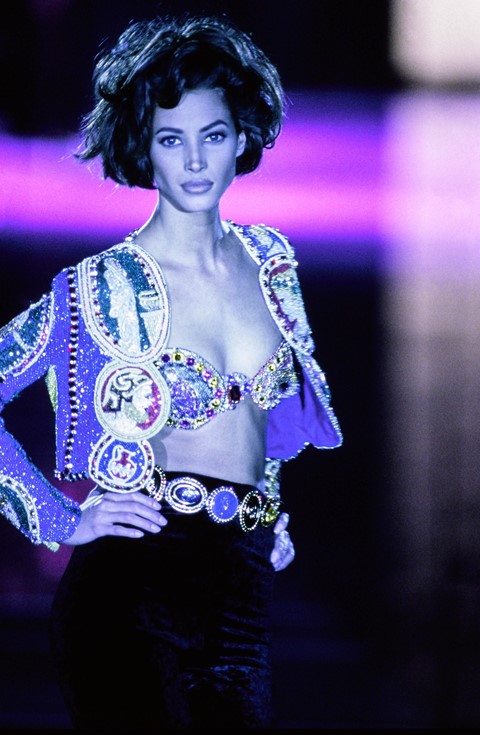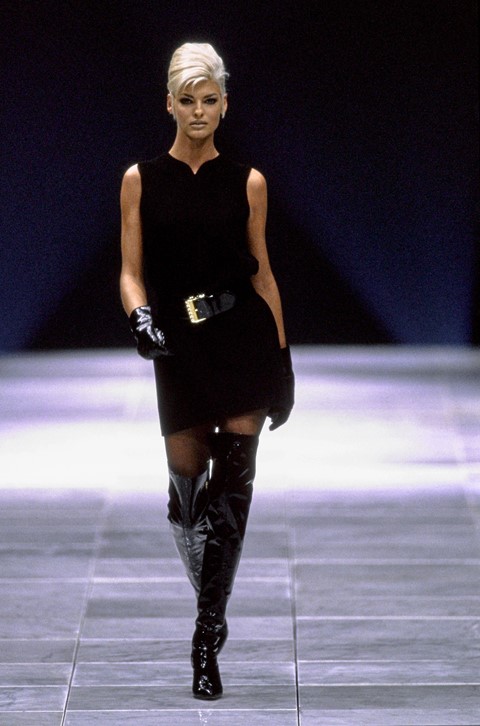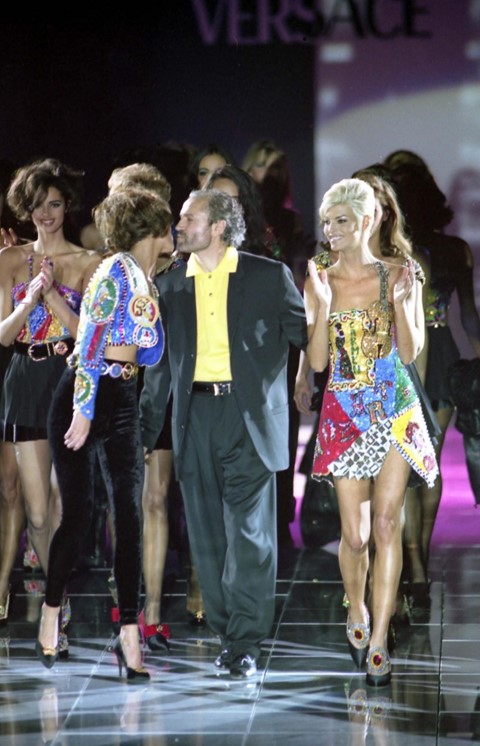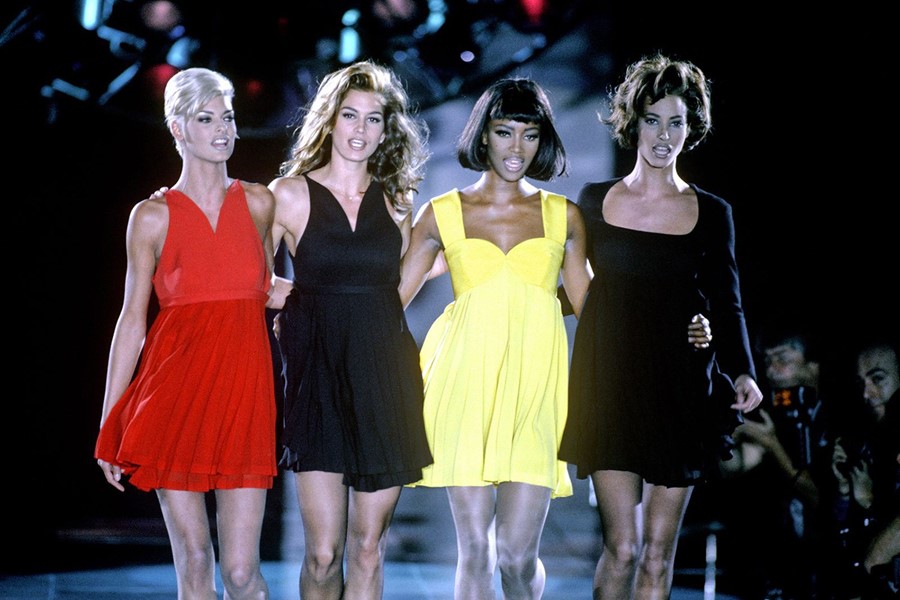20 years after the designer’s death, we remember his seminal A/W91 show – replete with what is arguably the most iconic catwalk finale of all time
Last month marked the 20th anniversary of the death of Gianni Versace, tragically murdered in cold blood outside Casa Casuarina, his Miami mansion in South Beach, on July 15, 1997. Two thousand mourners attended Versace’s memorial service filling Milan’s gothic cathedral, Il Duomo. Everyone from the supermodels who walked his shows and fronted his campaigns, to fashion industry editors, to friends and celebrities (including Elton John, Sting and Diana, Princess of Wales) came to pay their respects to a designer who in three decades had injected couture with fun, sex and glamour, changing the face of fashion in the process.
Born in Reggio di Calabria, Italy in 1946, the designer – who never formally trained – spent his early years observing his dressmaker mother in her studio. But it was while studying architectural drawing at a local technical college that Versace began developing his craft, first working as an apprentice buyer for his mother and then creating his own designs for her store. In 1972, he gravitated north to Milan, by then firmly established as Italy’s fashion capital, where he spent the next few years as a freelance designer for the Callaghan, Genny and Complice brands. In 1978, he launched his eponymous label, debuting his first womenswear ready-to-wear collection at the Palazzo della Permanente and opening his inaugural store the same year.
Supported commercially by his brother Santo and in due course creatively by his sister Donatella, Versace’s business became a truly Italian family affair. The empire expanded to encompass everything from the couture gowns of Atelier Versace to fragrance and extravagant home furnishings, not to mention myriad accessories bearing his now-iconic Medusa head. “When you are born in a place such as Calabria… you cannot help but be influenced by the classical past,” he once noted. And yet, he was also a decidedly modern designer, readily exploiting celebrity culture, pop music and modern materials, such as plastic and metal, to deliver an eclectic fusion of past and present, with an eye towards the future. He was also extremely PR savvy – boasting a business brain to match his creative talent. As Anna Wintour told The New York Times in the wake of his death, “He relished media attention and masterminded it, and everybody followed in his footsteps.” Arguably the most memorable example of this was his Autumn/Winter 1991 show – a moment that sparked the concept of catwalk show as excitement-inducing spectacle that we know so well today.

The Show
The show took place in the Fiera Milano exhibition hall, a short taxi ride outside of Milan’s main shopping district. A glimmering white marble catwalk stretched down the centre of the darkened space, measuring 15 metres long by three metres wide, and surrounded by a U-shaped formation of chairs. The seating was divided into various sections: buyers and press on the left, celebrities and loyal customers on the right, and international VIPs front and centre. On the back wall, giant black-and-white lettering spelt out ‘Gianni Versace’ in the house’s signature script. In juxtaposition to their monochromatic surroundings, the brightly coloured clothes were almost as vibrant as their Pop Art-inspired predecessors for Spring/Summer, but this time were interspersed by a heavy dose of black – a subtle precursor to the S&M influenced pieces that would emerge the following season. “I did black, [but] mixed with red, yellow, green, orange – every colour mixes well with black,” Versace explained post-show. “It’s a very, very happy black.”
Each look purveyed Versace’s signature aesthetic of sexy rock ‘n’ roll meets opulent glamour. The maximal power dressing trend of the 1980s still reigned triumphant, but with a fresh twist communicated through a range of boxy and bolero cropped jackets; form-fitting Lycra catsuits, boasting baroque patterns; layered plaids; pleated tennis and skater skirts; studded leather pieces – and, of course, plenty of embellishment. Dresses were short and laced up, or cinched in at the waist with large belts. Bold tights in block colours were paired with matching shoes or a variety of statement, thigh-high boots (some patent, others beguilingly decorated) – the very ones that Demna Gvasalia paid tribute to in his first collection for Balenciaga, followed by Anthony Vacerello in his A/W17 show for Saint Laurent. Oversized ornamental earrings adorned models’ ears, while backlighting transformed their bouncing blow-drys into huge halos.

The People
At the beginning of the 90s the notion of the supermodel had certainly been established, but no other designer harnessed its power quite like Versace, who seized upon the stars’ potential to generate headlines, and thus galvanise their icon status. This began with his powerful advertising campaigns – usually shot by Richard Avedon, and featuring such famous faces as Christy Turlington and Linda Evangelista. But for A/W91, following the advice of Liz Tilberis, the then editor of British Vogue, he decided, for the first time, to employ the same models to bring their star quality to the runway, with unprecedented results.
“The mood is happiness; it is modern, it is alive, it is a gift to the women,” stated Versace of the event, which saw scores of models, of Amazonian stature and classical beauty, sashay resolutely down the catwalk, either one by one or in small interacting clusters. But it is of course the show’s climactic finale that has earned its place in fashion history. The crowds fell silent as the inimitable sounds of George Michael’s Freedom! ’90 filled the hall, signalling the arrival on stage of supermodels Linda Evangelista, Cindy Crawford, Naomi Campbell and Christy Turlington, wearing red, yellow and black cocktail dresses and lip-synching along to the hit single in an epic reprisal of their appearance in the David Fincher-directed music video, released the previous year. The media descended into a frenzy amid rumours that the models had been paid between £25,000 and £50,000 for their contribution. Versace no doubt thought the money well spent – the event has since been canonised by Tim Blanks as “a Fashion moment of biblical proportions” thanks to its seminal influence on the runway show at large.

The Impact
It is rare now to see a show by one of the world’s biggest fashion houses that doesn’t include a supermodel or a famous face – or indeed a rousing soundtrack. But back then, the clever recreation of a hit video for a hit single, using icons usually seen exclusively in print or on-screen, was a truly unique and ingenious PR move by a designer at the top of his game. The show went pre-internet viral across the mainstream media, and its memory lives on in multiple YouTube clips and endlessly re-blogged social media posts. This moment marked the first major merging of fashion with celebrity, and the opening up of the fashion show to a public hungry for the extravaganza it promised.
Versace’s legacy endures not only in Donatella’s helming of the vast Versace empire but in the designs and shows of countless contemporary designers, including Olivier Rousteing, Christopher Kane, Jeremy Scott, Riccardo Tisci and Grace Wales Bonner, propagator of crystal embellishments. Versace brought new life and a very modern sense of fun to the catwalk – and indeed to fashion generally. “You look at his work as a whole, and there is a through line of the Versace energy and spirit,” Ingrid Sischy, former editor of Interview magazine and a close friend of the designer’s, neatly summarised. “It’s all him. But then it is [also] a diary of the things that have been going on in the world.”

